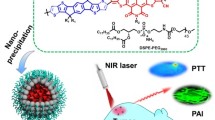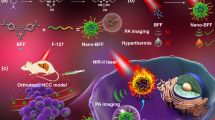Abstract
The development of near-infrared-II (NIR-II)-absorbing nano-agents for NIR-II photoacoustic imaging (PAI)-guided photothermal therapy (PTT) provides opportunities to advance the development of deep tissue photo-theranostics. Despite the superiority of semiconducting polymer nanoparticles (SPNs) for NIR-II PAI and PTT, their limited photoacoustic/photothermal performance makes achieving effective in vivo phototheranostics still a huge challenge. In this work, we propose a noncovalent conformational lock (NCL)-based molecular engineering strategy to improve the NIR-II photoacoustic/photothermal performance of SPNs for high-efficiency phototheranostics in vivo. The introduction of NCL is favorable to improve the backbone planarity of the semiconducting polymer to enhance the light-harvesting capability, resulting in amplified NIR-II photo-acoustic/photothermal output. By virtue of the low toxicity, suitable size, and improved photophysical properties, the optimal SPN3 not only can be efficiently internalized by 4T1 cancer cells to kill the cells under NIR-II light excitation but also light up the tumor profile via NIR-II PAI after systemic administration, which further guides the NIR-II PTT for efficient tumor ablation. Our investigation therefore provides a unique molecular design strategy to amplify the NIR-II photo-acoustic/photothermal signals of SPNs for improved in vivo phototheranostics.

摘要
开发近红外二区(NIR-II)响应的纳米制剂用于NIR-II光声成像 (PAI)引导的光热治疗(PTT)为推进深层组织光诊疗的发展提供了机遇. 尽管半导体聚合物纳米颗粒(SPNs)在NIR-II PAI和PTT中展现出巨大 的应用潜力, 但其有限的光声/光热效能使得实现高效的体内光诊疗仍 然是一个巨大的挑战. 本工作中, 我们提出了一种基于非共价键构象锁 (NCL)的分子工程策略来优化SPN的NIR-II光声/光热性能, 以实现高效 的体内光诊疗. NCL的引入有助于改善半导体聚合物主链的平面性, 增 强其捕光能力, 从而提高NIR-II光声/光热信号的输出. 优化出的SPN3 毒性低、尺寸合适、光物理性能好, 不仅能被4T1癌细胞有效摄取并在 NIR-II光激发下杀死细胞, 而且经全身给药后可通过NIR-II PAI点亮肿 瘤轮廓, 进一步指导NIR-II PTT的进行以实现高效的肿瘤热消融. 因此 本文的研究提供了一种独特的分子设计策略来放大SPN的NIR-II光声/光热信号, 最终实现活体高效光诊疗.
Similar content being viewed by others
References
Yang Z, Chen X. Semiconducting perylene diimide nanostructure: Multifunctional phototheranostic nanoplatform. Acc Chem Res, 2019, 52: 1245–1254
Liu Y, Bhattarai P, Dai Z, et al. Photothermal therapy and photo-acoustic imaging via nanotheranostics in fighting cancer. Chem Soc Rev, 2019, 48: 2053–2108
Yin C, Li X, Wang Y, et al. Organic semiconducting macromolecular dyes for NIR-II photoacoustic imaging and photothermal therapy. Adv Funct Mater, 2021, 31: 2104650
Wang LV, Hu S. Photoacoustic tomography: In vivo imaging from organelles to organs. Science, 2012, 335: 1458–1462
Borum RM, Moore C, Mantri Y, et al. Supramolecular loading of DNA hydrogels with dye-drug conjugates for real-time photoacoustic monitoring of chemotherapy. Adv Sci, 2023, 10: 2204330
Resink SG, Steenbergen W. Developing a stochastic model for acousto-optic tissue imaging. In: Conference on Photons Plus Ultrasound— Imaging and Sensing/Photonics West BiOS Symposium. San Francisco: SPEI, 2012
Zhang J, Sun X, Li H, et al. In vivo characterization and analysis of glioblastoma at different stages using multiscale photoacoustic molecular imaging. Photoacoustics, 2023, 30: 100462
Guo B, Chen J, Chen N, et al. High-resolution 3D NIR-II photoacoustic imaging of cerebral and tumor vasculatures using conjugated polymer nanoparticles as contrast agent. Adv Mater, 2019, 31: 1808355
Yin C, Wen G, Liu C, et al. Organic semiconducting polymer nano-particles for photoacoustic labeling and tracking of stem cells in the second near-infrared window. ACS Nano, 2018, 12: 12201–12211
Yin C, Zhen X, Fan Q, et al. Degradable semiconducting oligomer amphiphile for ratiometric photoacoustic imaging of hypochlorite. ACS Nano, 2017, 11: 4174–4182
Zhen X, Pu K. Development of optical nanoprobes for molecular imaging of reactive oxygen and nitrogen species. Nano Res, 2018, 11: 5258–5280
Yin C, Tang Y, Li X, et al. A single composition architecture-based nanoprobe for ratiometric photoacoustic imaging of glutathione (GSH) in living mice. Small, 2018, 14: 1703400
Lucero MY, Chan J. Photoacoustic imaging of elevated glutathione in models of lung cancer for companion diagnostic applications. Nat Chem, 2021, 13: 1248–1256
Cui X, Ruan Q, Zhuo X, et al. Photothermal nanomaterials: A powerful light-to-heat converter. Chem Rev, 2023, 123: 6891–6952
Yin C, Li X, Wen G, et al. Organic semiconducting polymer amphiphile for near-infrared-II light-triggered phototheranostics. Biomaterials, 2020, 232: 119684
Liu Y, Li Y, Koo S, et al. Versatile types of inorganic/organic NIR-IIa/IIb fluorophores: From strategic design toward molecular imaging and theranostics. Chem Rev, 2022, 122: 209–268
Smith AM, Mancini MC, Nie S. Second window for in vivo imaging. Nat Nanotech, 2009, 4: 710–711
Zhang Q, Guo Q, Chen Q, et al. Highly efficient 2D NIR-II photothermal agent with fenton catalytic activity for cancer synergistic photothermal-chemodynamic therapy. Adv Sci, 2020, 7: 1902576
Yan T, Su M, Wang Z, et al. Second near-infrared plasmonic nano-materials for photoacoustic imaging and photothermal therapy. Small, 2023, 19: 2300539
Zhang S, Guo W, Wei J, et al. Terrylenediimide-based intrinsic ther-anostic nanomedicines with high photothermal conversion efficiency for photoacoustic imaging-guided cancer therapy. ACS Nano, 2017, 11: 3797–3805
Li J, Pu K. Development of organic semiconducting materials for deep-tissue optical imaging, phototherapy and photoactivation. Chem Soc Rev, 2019, 48: 38–71
Zhang Z, Li W, Liu Y, et al. Semiconducting polymer nanoparticles in the second near-infrared region for biomedical imaging and therapy. Adv Opt Mater, 2023, 11: 2202052
Gupta N, Chan Y, Saha S, et al. Near-infrared-II semiconducting polymer dots for deep-tissue fluorescence imaging. Chem—An Asian J, 2021, 16: 175–184
Zhen X, Zhang C, Xie C, et al. Intraparticle energy level alignment of semiconducting polymer nanoparticles to amplify chemiluminescence for ultrasensitive in vivo imaging ofreactive oxygen species. ACS Nano, 2016, 10: 6400–6409
Duan X, Zhang Q, Jiang Y, et al. Semiconducting polymer nano-particles with intramolecular motion-induced photothermy for tumor phototheranostics and tooth root canal therapy. Adv Mater, 2022, 34: 2200179
Jiang Y, Huang J, Xu C, et al. Activatable polymer nanoagonist for second near-infrared photothermal immunotherapy of cancer. Nat Commun, 2021, 12: 742
Xu C, Jiang Y, Huang J, et al. Second near-infrared light-activatable polymeric nanoantagonist for photothermal immunometabolic cancer therapy. Adv Mater, 2021, 33: 2101410
Xu C, Pu K. Second near-infrared photothermal materials for combinational nanotheranostics. Chem Soc Rev, 2021, 50: 1111–1137
Wen K, Tan H, Peng Q, et al. Achieving efficient NIR-II type-I pho-tosensitizers for photodynamic/photothermal therapy upon regulating chalcogen elements. Adv Mater, 2022, 34: 2108146
Wen G, Li X, Zhang Y, et al. Effective phototheranostics of brain tumor assisted by near-infrared-II light-responsive semiconducting polymer nanoparticles. ACS Appl Mater Interfaces, 2020, 12: 33492–33499
Guo B, Sheng Z, Hu D, et al. Through scalp and skull NIR-II photo-thermal therapy of deep orthotopic brain tumors with precise photo-acoustic imaging guidance. Adv Mater, 2018, 30: 1802591
Wu J, You L, Lan L, et al. Semiconducting polymer nanoparticles for centimeters-deep photoacoustic imaging in the second near-infrared window. Adv Mater, 2017, 29: 1703403
Jiang Y, Duan X, Liu L, et al. NIR-II-absorbing conjugated polymers based on tetra-fused isoindigo ribbons for photothermal conversion and photoacoustic imaging. Cell Rep Phys Sci, 2022, 3: 100957
Zha M, Lin X, Ni JS, et al. An ester-substituted semiconducting polymer with efficient nonradiative decay enhances NIR-II photoacoustic performance for monitoring of tumor growth. Angew Chem Int Ed, 2020, 59: 23268–23276
Ie Y, Huang J, Uetani Y, et al. Synthesis, properties, and photovoltaic performances of donor-acceptor copolymers having dioxocycloalkene-annelated thiophenes as acceptor monomer units. Macromolecules, 2012, 45: 4564–4571
Huang H, Yang L, Facchetti A, et al. Organic and polymeric semiconductors enhanced by noncovalent conformational locks. Chem Rev, 2017, 117: 10291–10318
Yang G, Wang Y, Zhou S, et al. Water-dispersed semiconducting polymer for NIR-II fluorescence imaging and NIR-II laser-triggered photothermal therapy. Dyes Pigments, 2023, 210: 110960
Yin C, Tai X, Li X, et al. Side chain engineering of semiconducting polymers for improved NIR-II fluorescence imaging and photothermal therapy. Chem Eng J, 2022, 428: 132098
Acknowledgements
This work was supported by the National Natural Science Foundation of China (62005127), the Natural Science Foundation of Jiangsu Province (BK20200751), the Project of Jiangsu Specially-Appointed Professor (RK030STP22003), the Research Startup Fund of Nanjing University of Posts and Telecommunications (NY220068), and the Project of State Key Laboratory of Organic Electronics and Information Displays (ZS030ZR22014).
Author information
Authors and Affiliations
Contributions
Author contributions Fan Q and Yin C designed the project; Yin C wrote the manuscript; Chen Ying guided the biological experiments; Chen Yang and Yang G carried out the experiments; Li P conducted the theoretical calculation; Yin L and Chen L conducted the data analysis; Liu Y and Liang X were responsible for data checking. All authors contributed to the general discussion.
Corresponding authors
Ethics declarations
Conflict of interest The authors declare that they have no conflict of interest.
Additional information
Supplementary information Experimental details and supporting data are available in the online version of the paper.
Yang Chen is currently studying for his Master’s degree at Nanjing University of Posts and Telecommunications under the supervision of Professor Chao Yin. His main research interest is semiconducting nanoprobe-assisted photoacoustic imaging and photothermal therapy.
Chao Yin received his PhD degree from the Institute of Advanced Materials, Nanjing University of Posts and Telecommunications. After graduation, he moved to Chinese University of Hong Kong for postdoctoral research. Currently, he is a professor at Nanjing University of Posts and Telecommunications. His research is focused on the design and synthesis of multifunctional nanoma-terials based on organic semiconducting polymers/oligo-mers for biomedical applications.
Quli Fan is currently a professor at Nanjing University of Posts and Telecommunications, China. He received his BS and MS degrees from Nanjing University in 1996 and 1999, respectively. He obtained his PhD degree from the National University of Singapore in 2003. His research interest focuses on the development of smart and multi-functional NIR optical platform for understanding, detection, and treatment of life-threatening diseases.
Electronic Supplementary Material
40843_2023_2603_MOESM1_ESM.pdf
Noncovalent conformational lock-based molecular engineering improves NIR-II photoacoustic/photothermal performance of semiconducting polymer nanoparticles for efficient phototheranostics
Rights and permissions
About this article
Cite this article
Chen, Y., Yang, G., Li, P. et al. Noncovalent conformational lock-based molecular engineering improves NIR-II photoacoustic/photothermal performance of semiconducting polymer nanoparticles for efficient phototheranostics. Sci. China Mater. 66, 4865–4874 (2023). https://doi.org/10.1007/s40843-023-2603-6
Received:
Accepted:
Published:
Issue Date:
DOI: https://doi.org/10.1007/s40843-023-2603-6




